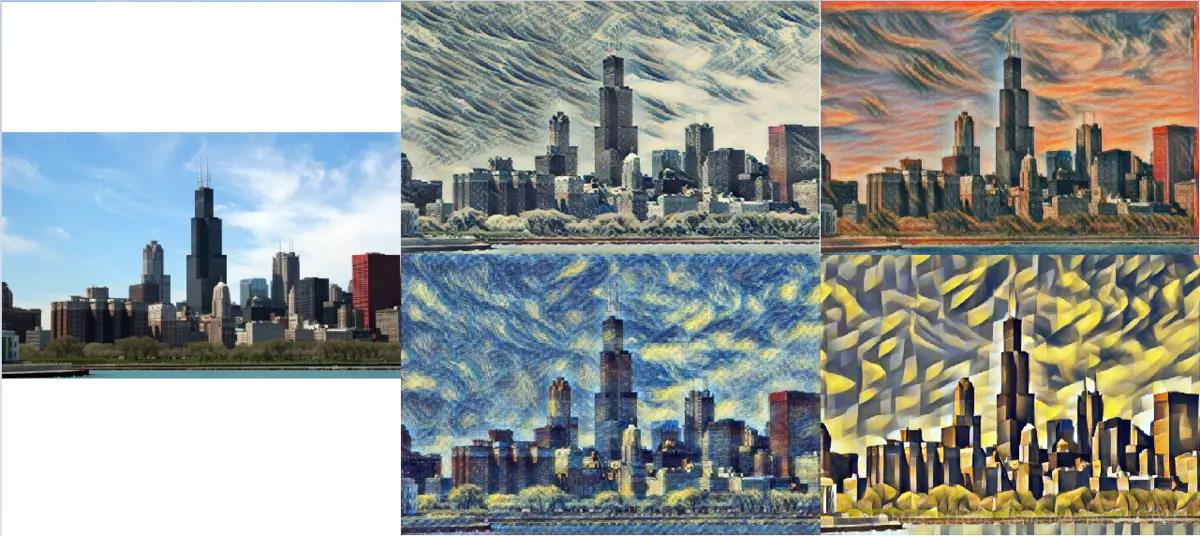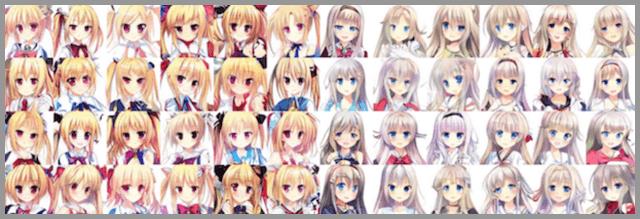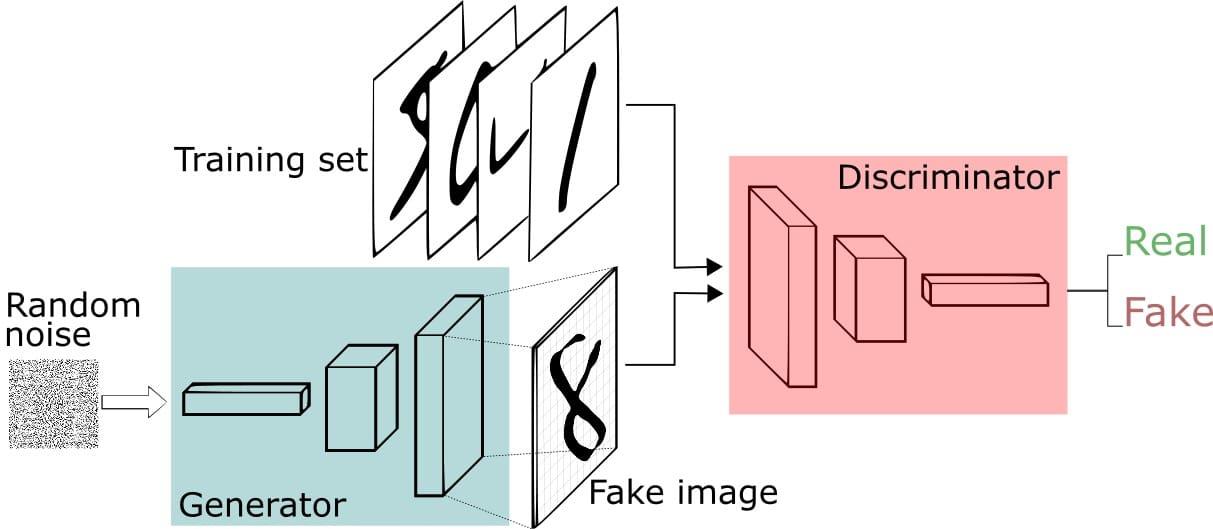深度学习100例-生成对抗网络(GAN)手写数字生成 | 第18天
Posted K同学啊
tags:
篇首语:本文由小常识网(cha138.com)小编为大家整理,主要介绍了深度学习100例-生成对抗网络(GAN)手写数字生成 | 第18天相关的知识,希望对你有一定的参考价值。
🔱 大家好,我是 👉 K同学啊,《深度学习100例》系列将持续更新 欢迎 点赞👍、收藏⭐、关注👀
文章目录
本文将采用 GAN 模型实现手写数字的生成,重点是了解 GAN 模型的结构及其搭建方法。
一、前期工作
🚀 我的环境:
- 语言环境:Python3.6.5
- 编译器:jupyter notebook
- 深度学习环境:TensorFlow2.4.1
🚀 深度学习新人必看:
🚀 往期精彩-卷积神经网络篇:
- 深度学习100例-卷积神经网络(CNN)实现mnist手写数字识别 | 第1天
- 深度学习100例-卷积神经网络(CNN)彩色图片分类 | 第2天
- 深度学习100例-卷积神经网络(CNN)服装图像分类 | 第3天
- 深度学习100例-卷积神经网络(CNN)花朵识别 | 第4天
- 深度学习100例-卷积神经网络(CNN)天气识别 | 第5天
- 深度学习100例-卷积神经网络(VGG-16)识别海贼王草帽一伙 | 第6天
- 深度学习100例-卷积神经网络(VGG-19)识别灵笼中的人物 | 第7天
- 深度学习100例-卷积神经网络(ResNet-50)鸟类识别 | 第8天
- 深度学习100例-卷积神经网络(AlexNet)手把手教学 | 第11天
- 深度学习100例-卷积神经网络(CNN)识别验证码 | 第12天
- 深度学习100例-卷积神经网络(Inception V3)识别手语 | 第13天
- 深度学习100例-卷积神经网络(Inception-ResNet-v2)识别交通标志 | 第14天
- 深度学习100例-卷积神经网络(CNN)实现车牌识别 | 第15天
- 深度学习100例-卷积神经网络(CNN)识别神奇宝贝小智一伙 | 第16天
- 深度学习100例-卷积神经网络(CNN)注意力检测 | 第17天
🚀 往期精彩-循环神经网络篇:
🚀 本文选自专栏:《深度学习100例》
1. 设置GPU
如果使用的是CPU可以注释掉这部分的代码。
import tensorflow as tf
gpus = tf.config.list_physical_devices("GPU")
if gpus:
tf.config.experimental.set_memory_growth(gpus[0], True) #设置GPU显存用量按需使用
tf.config.set_visible_devices([gpus[0]],"GPU")
# 打印显卡信息,确认GPU可用
print(gpus)
[PhysicalDevice(name='/physical_device:GPU:0', device_type='GPU')]
from tensorflow.keras import layers, datasets, Sequential, Model, optimizers
from tensorflow.keras.layers import LeakyReLU, UpSampling2D, Conv2D
import matplotlib.pyplot as plt
import numpy as np
import sys,os,pathlib
2. 定义训练参数
img_shape = (28, 28, 1)
latent_dim = 200
二、什么是生成对抗网络
1. 简单介绍
生成对抗网络(GAN) 包含生成器和判别器,两个模型通过对抗训练不断学习、进化。
-
生成器(Generator):生成数据(大部分情况下是图像),目的是“骗过”判别器。 -
鉴别器(Discriminator):判断这张图像是真实的还是机器生成的,目的是找出生成器生成的“假数据”。
2. 应用领域
GAN 的应用十分广泛,它的应用包括图像合成、风格迁移、照片修复以及照片编辑,数据增强等等。
1)风格迁移
图像风格迁移是将图像A的风格转换到图像B中去,得到新的图像。

2)图像生成
GAN 不但能生成人脸,还能生成其他类型的图片,比如漫画人物。

三、网络结构
简单来讲,就是用生成器生成手写数字图像,用鉴别器鉴别图像的真假。二者相互对抗学习(卷),在对抗学习(卷)的过程中不断完善自己,直至生成器可以生成以假乱真的图片(鉴别器无法判断其真假)。结构图如下:

GAN步骤:
- 1.生成器(Generator)接收随机数并返回生成图像。
- 2.将生成的数字图像与实际数据集中的数字图像一起送到鉴别器(Discriminator)。
- 3.鉴别器(Discriminator)接收真实和假图像并返回概率,0到1之间的数字,1表示真,0表示假。
四、构建生成器
def build_generator():
# ======================================= #
# 生成器,输入一串随机数字生成图片
# ======================================= #
model = Sequential([
layers.Dense(256, input_dim=latent_dim),
layers.LeakyReLU(alpha=0.2), # 高级一点的激活函数
layers.BatchNormalization(momentum=0.8), # BN 归一化
layers.Dense(512),
layers.LeakyReLU(alpha=0.2),
layers.BatchNormalization(momentum=0.8),
layers.Dense(1024),
layers.LeakyReLU(alpha=0.2),
layers.BatchNormalization(momentum=0.8),
layers.Dense(np.prod(img_shape), activation='tanh'),
layers.Reshape(img_shape)
])
noise = layers.Input(shape=(latent_dim,))
img = model(noise)
return Model(noise, img)
五、构建鉴别器
def build_discriminator():
# ===================================== #
# 鉴别器,对输入的图片进行判别真假
# ===================================== #
model = Sequential([
layers.Flatten(input_shape=img_shape),
layers.Dense(512),
layers.LeakyReLU(alpha=0.2),
layers.Dense(256),
layers.LeakyReLU(alpha=0.2),
layers.Dense(1, activation='sigmoid')
])
img = layers.Input(shape=img_shape)
validity = model(img)
return Model(img, validity)

- 鉴别器训练原理:通过对输入的图片进行鉴别,从而达到提升的效果
- 生成器训练原理:通过鉴别器对其生成的图片进行鉴别,来实现提升
# 创建判别器
discriminator = build_discriminator()
# 定义优化器
optimizer = tf.keras.optimizers.Adam(1e-4)
discriminator.compile(loss='binary_crossentropy',
optimizer=optimizer,
metrics=['accuracy'])
# 创建生成器
generator = build_generator()
gan_input = layers.Input(shape=(latent_dim,))
img = generator(gan_input)
# 对生成的假图片进行预测
validity = discriminator(img)
combined = Model(gan_input, validity)
combined.compile(loss='binary_crossentropy', optimizer=optimizer)
六、训练模型
1. 保存样例图片
def sample_images(epoch):
"""
保存样例图片
"""
row, col = 4, 4
noise = np.random.normal(0, 1, (row*col, latent_dim))
gen_imgs = generator.predict(noise)
fig, axs = plt.subplots(row, col)
cnt = 0
for i in range(row):
for j in range(col):
axs[i,j].imshow(gen_imgs[cnt, :,:,0], cmap='gray')
axs[i,j].axis('off')
cnt += 1
fig.savefig("images/%05d.png" % epoch)
plt.close()
2. 训练模型
train_on_batch:函数接受单批数据,执行反向传播,然后更新模型参数,该批数据的大小可以是任意的,即,它不需要提供明确的批量大小,属于精细化控制训练模型。
def train(epochs, batch_size=128, sample_interval=50):
# 加载数据
(train_images,_), (_,_) = tf.keras.datasets.mnist.load_data()
# 将图片标准化到 [-1, 1] 区间内
train_images = (train_images - 127.5) / 127.5
# 数据
train_images = np.expand_dims(train_images, axis=3)
# 创建标签
true = np.ones((batch_size, 1))
fake = np.zeros((batch_size, 1))
# 进行循环训练
for epoch in range(epochs):
# 随机选择 batch_size 张图片
idx = np.random.randint(0, train_images.shape[0], batch_size)
imgs = train_images[idx]
# 生成噪音
noise = np.random.normal(0, 1, (batch_size, latent_dim))
# 生成器通过噪音生成图片,gen_imgs的shape为:(128, 28, 28, 1)
gen_imgs = generator.predict(noise)
# 训练鉴别器
d_loss_true = discriminator.train_on_batch(imgs, true)
d_loss_fake = discriminator.train_on_batch(gen_imgs, fake)
# 返回loss值
d_loss = 0.5 * np.add(d_loss_true, d_loss_fake)
# 训练生成器
noise = np.random.normal(0, 1, (batch_size, latent_dim))
g_loss = combined.train_on_batch(noise, true)
print ("%d [D loss: %f, acc.: %.2f%%] [G loss: %f]" % (epoch, d_loss[0], 100*d_loss[1], g_loss))
# 保存样例图片
if epoch % sample_interval == 0:
sample_images(epoch)
train(epochs=30000, batch_size=256, sample_interval=200)
0 [D loss: 0.587824, acc.: 67.77%] [G loss: 0.634870]
1 [D loss: 0.387015, acc.: 74.22%] [G loss: 0.541133]
2 [D loss: 0.380705, acc.: 63.67%] [G loss: 0.455188]
3 [D loss: 0.408720, acc.: 56.25%] [G loss: 0.405431]
4 [D loss: 0.445802, acc.: 52.34%] [G loss: 0.343866]
......
176 [D loss: 0.394246, acc.: 66.41%] [G loss: 0.648134]
177 [D loss: 0.393966, acc.: 66.21%] [G loss: 0.640118]
178 [D loss: 0.402815, acc.: 65.62%] [G loss: 0.641665]
179 [D loss: 0.404573, acc.: 65.82%] [G loss: 0.647686]
180 [D loss: 0.394707, acc.: 67.19%] [G loss: 0.631329]
......
七、生成动图
如果报错:ModuleNotFoundError: No module named 'imageio' 可以使用:pip install imageio 安装 imageio 库。
import imageio
def compose_gif():
# 图片地址
data_dir = "F:/jupyter notebook/DL-100-days/code/images"
data_dir = pathlib.Path(data_dir)
paths = list(data_dir.glob('*'))
gif_images = []
for path in paths:
print(path)
gif_images.append(imageio.imread(path))
imageio.mimsave("test.gif",gif_images,fps=2)
compose_gif()
F:\\jupyter notebook\\DL-100-days\\code\\images\\00000.png
F:\\jupyter notebook\\DL-100-days\\code\\images\\00200.png
F:\\jupyter notebook\\DL-100-days\\code\\images\\00400.png
F:\\jupyter notebook\\DL-100-days\\code\\images\\00600.png
F:\\jupyter notebook\\DL-100-days\\code\\images\\00800.png
F:\\jupyter notebook\\DL-100-days\\code\\images\\01000.png
.....
图片的生成过程展示(约50s):

深度学习新人必看:
往期精彩
- 深度学习100例-卷积神经网络(CNN)实现mnist手写数字识别 | 第1天
- 深度学习100例-卷积神经网络(CNN)彩色图片分类 | 第2天
- 深度学习100例-卷积神经网络(CNN)服装图像分类 | 第3天
- 深度学习100例-卷积神经网络(CNN)花朵识别 | 第4天
- 深度学习100例-卷积神经网络(CNN)天气识别 | 第5天
- 深度学习100例-卷积神经网络(VGG-16)识别海贼王草帽一伙 | 第6天
- 深度学习100例-卷积神经网络(VGG-19)识别灵笼中的人物 | 第7天
- 深度学习100例-卷积神经网络(ResNet-50)鸟类识别 | 第8天
- 深度学习100例-循环神经网络(RNN)实现股票预测 | 第9天
- 深度学习100例-循环神经网络(LSTM)实现股票预测 | 第10天
- 深度学习100例-卷积神经网络(AlexNet)手把手教学 | 第11天
- 深度学习100例-卷积神经网络(CNN)识别验证码 | 第12天
- 深度学习100例-卷积神经网络(Inception V3)识别手语 | 第13天
- 深度学习100例-卷积神经网络(Inception-ResNet-v2)识别交通标志 | 第14天
- 深度学习100例-卷积神经网络(CNN)实现车牌识别 | 第15天
- 深度学习100例-卷积神经网络(CNN)识别神奇宝贝小智一伙 | 第16天
- 深度学习100例-卷积神经网络(CNN)注意力检测 | 第17天
🚀 来自专栏:《深度学习100例》
未完~
持续更新 欢迎 点赞👍、收藏⭐、关注👀
- 点赞👍:点赞给我持续更新的动力
- 收藏⭐️:收藏后你能够随时找到文章
- 关注👀:关注我第一时间接收最新文章
以上是关于深度学习100例-生成对抗网络(GAN)手写数字生成 | 第18天的主要内容,如果未能解决你的问题,请参考以下文章